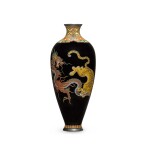
Property from the John and Muriel Okladek Collection
A cloisonné enamel vase with dragon and tiger | Signed on a silver tablet Kyoto Namikawa (workshop of Namikawa Yasuyuki, 1845-1927), but attributed to Shibata | Meiji period, late 19th century
Lot Closed
November 3, 02:07 PM GMT
Estimate
80,000 - 100,000 GBP
Lot Details
Description
Property from the John and Muriel Okladek Collection
A cloisonné enamel vase with dragon and tiger
Signed on a silver tablet Kyoto Namikawa (workshop of Namikawa Yasuyuki, 1845-1927), but attributed to Shibata
Meiji period, late 19th century
the oviform vase decorated in various coloured enamels and worked in silver wire on a deep black ground, with a dragon and tiger in battle (ryuko), the details intricately delineated, the shoulder with a band imitating a brocade cloth cover, decorated with blue and red stylised chrysanthemum heads, karakusa and hanabishi, signed on a silver tablet Kyoto Namikawa (workshop of Namikawa Yasuyuki, 1845-1927), but attributed to Shibata
18 cm., 7⅛ in. high
You May Also Like








![A kawari-kabuto [eccentrically shaped helmet], Japan, Edo period, 18th century](https://dam.sothebys.com/dam/image/lot/dd7807cb-aab4-404f-bff8-b086781fc9cd/primary/extra_small)

